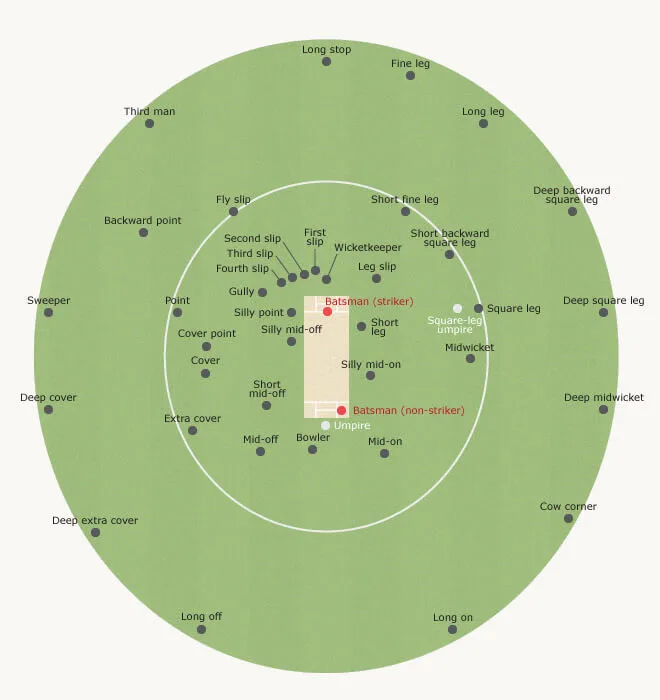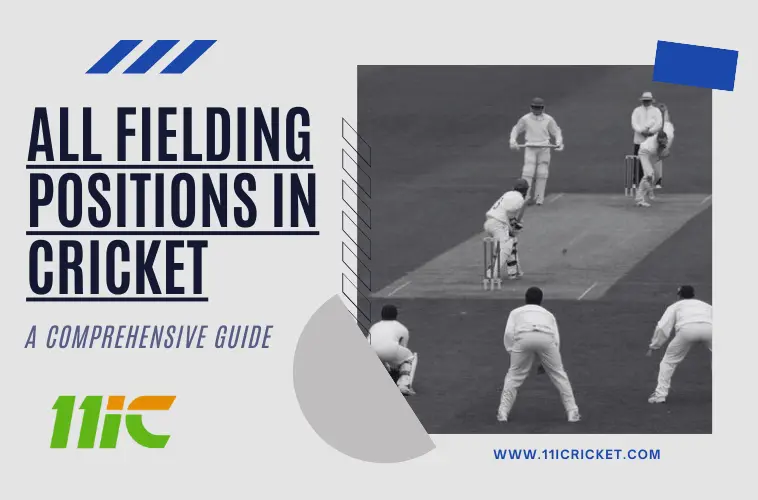All Fielding Positions in Cricket: A Comprehensive Guide
Cricket‘s magic lies in the intricate interplay between batting, bowling, and fielding. A strong batting display builds a winning score. Meanwhile, clever bowlers disrupt the opposition. However, fielding is the often-overlooked hero. It’s not just about preventing runs. Sharp fielding creates chances for dismissals like run-outs and catches. All fielding positions in cricket are not random. The captain strategically places fielders based on the bowler’s style and the batsman’s weakness. The match situation also influences field placements. This creates fielding traps, exploits batsman flaws, and adapts to the game’s flow. Ultimately, cricket is a beautiful blend of these three elements. Powerful shots and great bowling performances grab attention. However, remember that strategic fielding is essential to the game’s beauty.
Fielding Position Names and Their Locations
A cricket team consists of 11 players, including a bowler and a wicket-keeper. This leaves nine fielding positions available at any given time. The placement of fielders is a strategic decision made by the team’s captain. This is often done in consultation with the bowler and sometimes other team members. Players can reposition fielders at any time except when the bowler is delivering the ball. However, exceptions exist for anticipatory movements.
All fielding positions in cricket have specific names. Some of these positions are commonly used, while others are less so. These positions are not fixed and can vary. Their names follow a system similar to polar coordinates. Terms like leg, cover, and mid-wicket describe the angle from the batter, often paired with adjectives indicating distance (silly, short, deep, or long) or additional descriptors like backward, forward, or square.
The diagram illustrates most named fielding positions for a right-handed batter. The area to the batter’s left is the leg side (or on side). Meanwhile, the right side is the off side. For a left-handed batter, these sides reverse, and the fielding positions mirror the ones shown.

All Fielding Positions in Cricket
The Inner Ring
Wicket-Keeper (WK):
The only fielder allowed to wear gloves. Wicket-keeper crouches directly behind the stumps. They are the captain’s eyes behind the batsman, collecting the ball and effecting stumpings. They also offer invaluable guidance to the bowler.
Slips (1st, 2nd, 3rd, Occasionally 4th):
This fielding position is close behind the batsman on the off-side (where the batsman bats). Slips are responsible for catching edges that carry off the bat towards the wicket-keeper. They require exceptional reflexes, anticipation, and the ability to judge the trajectory of the ball at lightning speed.
Gully:
Slightly wider than the slips on the off-side, the gully fielder covers drives and cuts that escape the grasp of the slips. They need a good combination of catching and throwing skills.
Point:
Standing behind square on the off-side, the point fielder covers the area between gully and cover. This fielder intercepts powerful drives and cuts. They are a crucial cog in the fielding unit.
Cover (Extra Cover):
Patrolling a wider area behind the point on the off-side, the cover fielder intercepts powerful drives and lofted shots. They require good athleticism and a strong arm.
Mid-Off:
This fielding position is halfway between the bowler and the batsman on the off-side. The mid-off fielder stops straight shots played along the ground. They need quick reflexes and accurate throwing skills.
Mid-On:
Mirroring the mid-off position on the leg side (opposite the batsman’s stance), the mid-on fielder intercepts straight shots and leg-side glances.
Mid-Wicket:
Standing square behind the wicket, the mid-wicket fielder covers flicks, glances, and balls that deviate off the pitch. They need excellent agility and anticipation skills.
On the Legside (Batsman's Left Side)
Leg Slip:
A close-in fielder positioned on the leg side (opposite the slips) to catch balls glancing off the batsman’s pads.
Silly Point:
Even closer to the batsman than the leg slip, this specialist fielder anticipates balls that turn sharply off the pitch. These balls, often from spin bowling, might take a nick off the bat.
Short Leg:
This fielding position stands very close to the leg side of the wicket. This fielder positions themselves for balls that get very low or deflect off the pads. They require exceptional reflexes and courage, as they often face powerful drives.
Square Leg:
Located behind the short leg, the square leg fielder cuts off balls played behind the square (between mid-wicket and the wicket-keeper). They’re responsible for stopping boundaries in this region.
The Outer Ring
Long-Off:
Patrolling the deep off-side boundary, the long-off fielder prevents fours and sixes hit over the bowler’s head. They require a strong arm and good judgment of trajectories.
Long-On:
This fielding position is similar to the long-off fielder. The long-on patrols the deep leg-side boundary, preventing fours and sixes.
Third Man:
Positioned near the fine leg boundary on the leg-side, the third man fielder intercepts flicks and glances. They also handle mistimed shots towards the leg side.
Fine Leg:
This fielding position in cricket stands closer to the batsman on the leg-side boundary compared to third man. The fine leg fielder covers flicks, glances, and balls that glance off the wicket-keeper’s gloves.
Deep Square Leg:
A fielder positioned behind the square leg umpire, patrolling the deep square leg boundary and preventing boundaries.
Long Stop:
Positioned even further back than the long-off and long-on fielders, the long stop acts as a safety net. This fielder catches balls that evade the other fielders.
Understanding All Fielding Positions in Cricket
Fielding positions in cricket are mostly named based on a system of polar coordinates. One word (Leg, Cover, Mid-wicket) describes them, indicating the angle from the batsman. This is optionally preceded by an adjective indicating the distance from the batsman (silly, short, deep, long).
Leg refers to the side of the batsman’s leg.
On side, which is also the batsman’s leg side, is denoted by “On”.
Off side, the opposite of the leg side, is referred to as “Off”.
Fielding positions’ distances from the batsman are described as:
Silly indicates a very close distance.
Short suggests a quite close distance.
Mid signifies a midpoint to the boundary.
Long and Deep describe positions closer to the boundary.
The angles from the batsmen are described as:
Square: along an imaginary extension of the popping crease.
Backward: behind square and the batsmen.
Forward: in front of square and the batsmen.
Fine: closer to an extended imaginary line running along the middle of the pitch, bisecting the stumps.
Wide: further from this extended imaginary line along the middle of the pitch, bisecting the stumps.
Conclusion
Fielding is often considered an underrated aspect of cricket. All fielding positions in cricket play a vital role in determining the game’s outcome. By understanding all fielding positions in cricket and their roles, you can appreciate the game better. Additionally, this knowledge can help you become a valuable asset in the field. Remember, practice and dedication are key. A keen cricketing mind can transform you from a spectator to a skilled fielder. So, grab a ball, find some space, and start practicing! You might just be the next fielding sensation everyone admires.
Also Read: Powerplay in T20 Cricket

